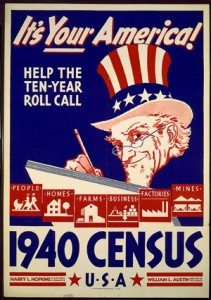Update 12 noon Tuesday (Census Release Day Two): Success! This morning before leaving for work, I successfully downloaded the 40 pages of census schedules that cover the North Side Chicago enumeration district where my dad lived in 1940. Still haven't had a chance to look at them, though. The experience was a little odd: After seeing nothing happen all day yesterday and in fact late into the night, I stopped expecting the National Archives to deliver any records. Can't wait to dig into them.
And speaking of the National Archives, its 1940 census site carries an acknowledgment that its performance has been less than ideal:
Thank you for your patience as we continue to address issues with the 1940 census web site. We have implemented changes so you can now view and download the census images. We are continuing to work on the site and expect to make further enhancements during the day on Tuesday, April 3rd.
One wonders what sort of battle-testing the census site got before it went live yesterday.
Update 12:40 p.m.: It's official: the 1940 census release is a colossal big first-day dud—so far. If you're one of the millions who have been trying to view census records, it's been a frustrating few hours with the National Archives site grinding away and delivering mostly nothing. Here's why, by way of the Los Angeles Times:
"In the first three hours, we had 22.5-million hits on the site," said National Archives and Records Administration spokeswoman Susan Cooper. "We're a victim of our own success."
Cooper said the archives had anticipated significant interest in the public release of the census, the first time such information has been available online, but not quite as much as materialized.
"It’s frustrating and we share that frustration with the public," Cooper said. She said some people are getting through on the website, but many are not. "We’re working as fast as we can to fix the problem."
Update, 9:20 a.m.: Well, the census records are out there, but I guess the National Archives site is getting slammed. I've spent the last hour or so waiting for the schedules from one San Francisco enumeration district to appear. It's like going back to the early days of dial-up 1200-baud modems.]

